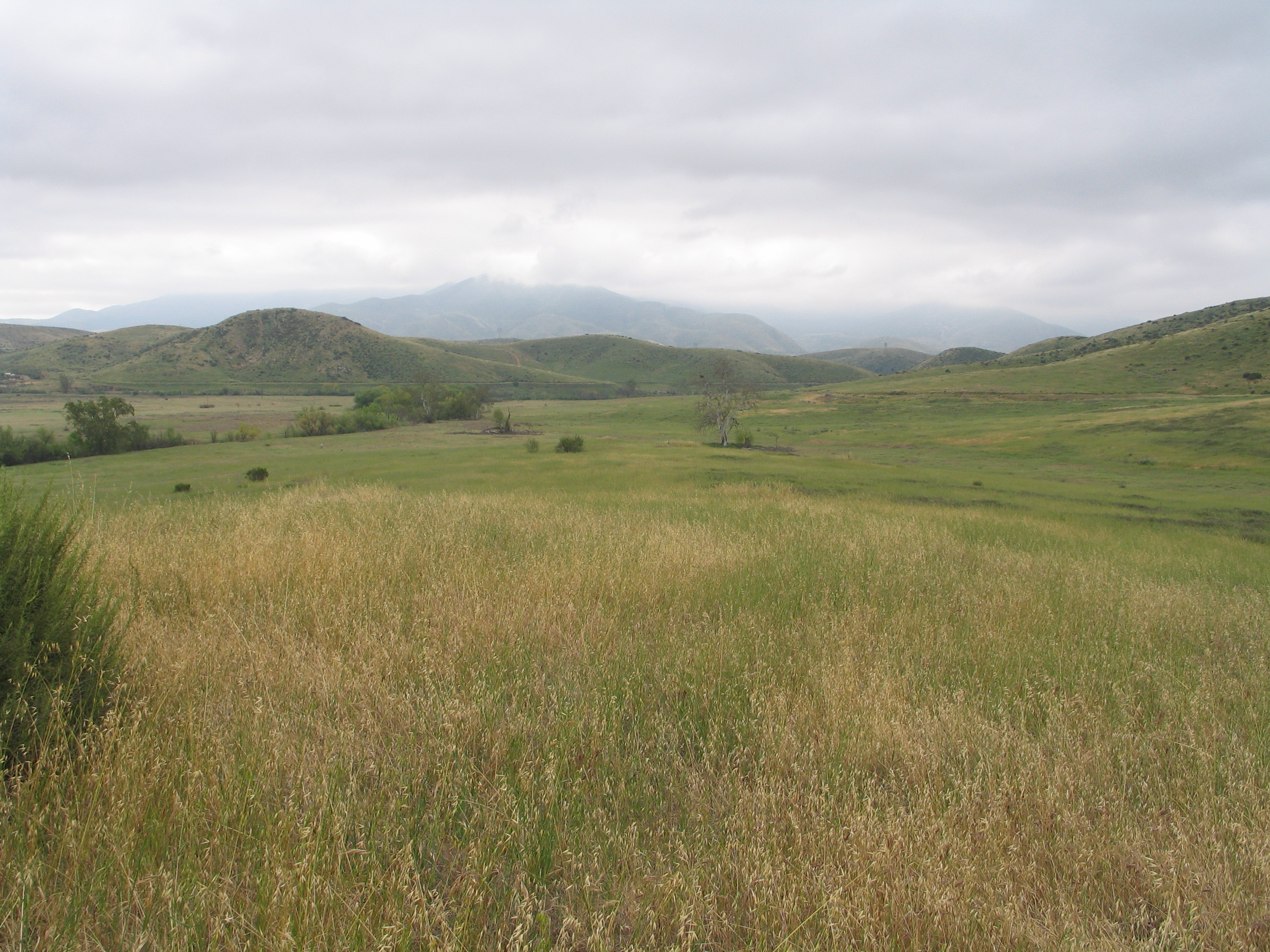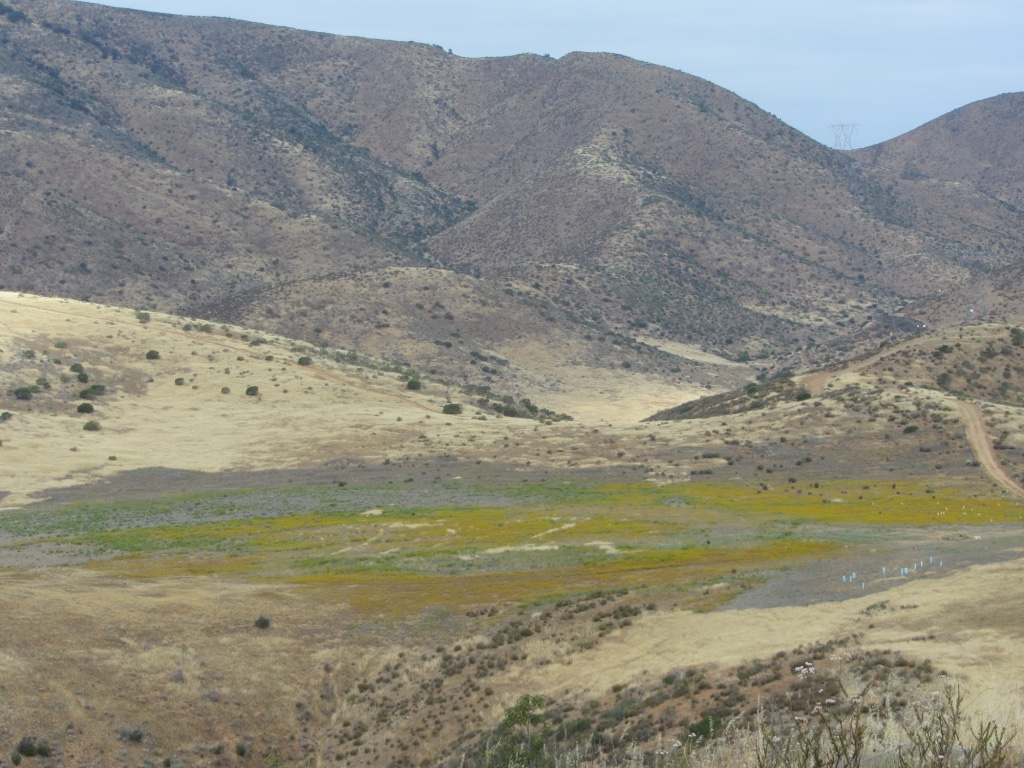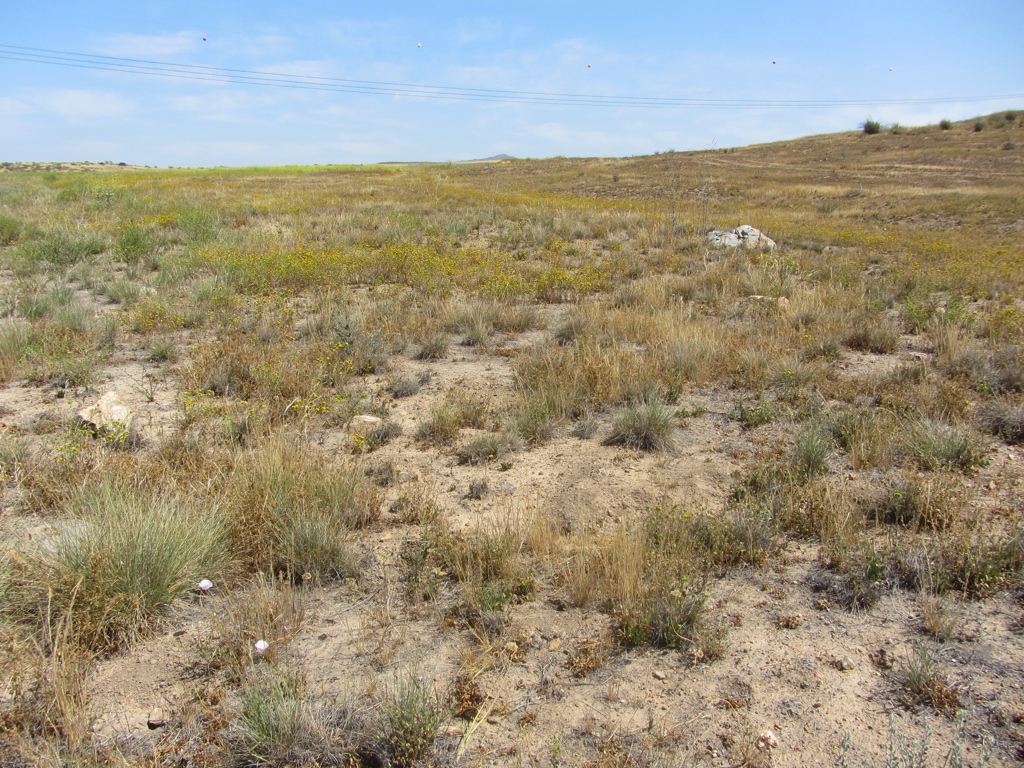Brief Community Description
The grassland vegetation community in San Diego County is comprised of grasslands dominated by native grasses and a growing amount of grasslands dominated by nonnative grasses. Grasslands are considered native if they have 20% aerial cover of native species [1]. Nonnative grasslands are much more prevalent than native grasslands in the MSPA [2].
Native grasslands include valley needlegrass grasslands, valley sacaton grasslands, and saltgrass grasslands [1]. The valley needlegrass grassland is a midheight (to 2 ft) grassland dominated by perennial, tussock-forming Nasella pulchra with native and introduced annuals occurring between the perennials, such as Sanicula, Sidalcea, Sisyrinchium, Eschscholzia, or Lasthenia. The Valley Sacaton Grassland is a midheight (to 3 ft) tussock-forming grassland dominated by Sporobolus airoides. Saltgrass grasslands are a low (less than 20cm) grassland dominated by saltgrass (Distichlis spicata).
Nonnative grasslands, or annual grasslands, have sparse to dense cover of annual grasses [1]. They are associated with numerous species of showy-flowered, native annual forbs ("wildflowers"), especially in favorable rainfall years. In San Diego County the presence of nonnative Avena, Bromus, Erodium, and Brassica are common indicators. Depending on past disturbance and annual rainfall, annual forbs may be the dominant species in some areas; however, it is presumed that nonnative grasses will soon dominate.
Alliances
The grassland vegetation community includes 2 native grassland alliances and 5 nonnative semi-natural stands of nonnative grasses and forbs in the western portion of the MSPA that are mapped to the alliance level [3]. The Nasella pulchra alliance is mapped on over 1,200 acres and is dominated by this native bunchgrass or it is present with other native perennial grasses and forbs [4]. The Leymus triticoides alliance is dominated by this native grass species or codominant with other native and nonnative grasses and forbs. It is mapped on only one acre in the area of the MSPA mapped to alliance level [1]. Most grassland is classified as Mediterranean California naturalized annual and perennial semi-natural grassland in which nonnative grasses and forbs are dominant over native species [2].
Range wide dist. status
Valley needlegrass grassland was formerly extensive around the Sacramento, San Joaquin, and Salinas Valleys, as well as the Los Angeles Basin, but is now much reduced [1]. Valley sacaton grassland was formerly extensive in the Tulare Lake Basin and along the San Joaquin Valley trough north to Stanislaus and Contra Costa Counties, but is now much reduced. Nonnative and annual grasslands are found in the valleys and foothills of most of California except for the north coastal and desert regions. Usually found below 3000 ft, but can reach 4000 ft in the Tehachapi Mountains and interior San Diego County. Formerly occupied large portions of the Sacramento, San Joaquin, and Salinas Valleys as well as the Los Angeles Basin, areas that are now agricultural or urban.
MSPA distribution
Grassland is the third most abundant and widespread vegetation community in the MSPA with 135,749 acres in all MUs, 47,731 acres (35%) of which are conserved [2]. Grasslands in order of abundance are most prevalent in MUs 9, 10, 3, 5, and 6. Valley needlegrass grassland occurs in Alpine (Wright’s Field), Ramona, Olivenhain, San Marcos, Camp Pendleton, Rincon, Mesa Grande, Eagle Peak Road, and Otay Mesa [1]. Valley sacaton grassland occurs in Ramona, Cottonwood Valley, Jacumba, and San Marcos. Saltgrass grasslands occur in Ramona, Lake Hodges, and other areas throughout the county. Nonnative and annual grasslands can be found throughout the County, but notable areas include: Otay Mesa, Barona, parts of Henshaw Valley, Borrego Springs, Love Valley, Santa Maria Valley, and Rancho Guejito. There are 29 MSP species that use grassland habitats; some are closely associated only with native grasslands, while others are affiliated with nonnative grasslands [2].
Habitat affinities
Valley needlegrass grassland usually occur on fine-textured (often clay) soils that are moist or waterlogged during winter, but very dry in summer [1]. In San Diego County valley needlegrass grassland becomes montane perennial grassland above approximately 2,000 feet. Valley sacaton grasslands occur on fine textured, poorly drained, usually alkaline soils. Most sites have seasonally high water tables or are overflowed during winter flooding. Saltgrass stands form in inland alkaline settings such as around playa edges and springs in the desert, as well as upper coastal salt marshes [4]. Saltgrass grasslands occur on fine textured, usually alkaline soils that are poorly drained [1]. Intergrades and often co-occurs with alkali meadow and various riparian habitats. Nonnative and annual grasslands occur on fine-textured, often clay soils, moist or even waterlogged during the winter rainy season and very dry during the summer and fall. Oak woodland is often adjacent on moister, better drained soils.
Ecosystem processes
For nonnative and annual grasslands, germination occurs with the onset of the late fall rains [1]. Growth, flowering, and seed-set occur from winter through spring. With a few exceptions, the plants are dead through the summer-fall dry season, persisting as seeds.
Threats
A primary threat to native grassland is loss, fragmentation, and degradation due to urban and agricultural development [2]. In areas altered by high fire frequency, deep tilling of soils, and/or intensive grazing, nonnative bromes and “false†bromes may become abundant and dominate the vegetation [1]. Invasive nonnative grasses and forbs are the largest threat to remaining native grasslands [3]. Nonnative grasses can prevent native ephemerals from sprouting through competitive interactions. Desert vegetation invaded by Bromus rubens and Schismus spp. may convert to semi-natural grasslands with frequent fire [4].
Special considerations
Nonnative grasslands that provide foraging and burrowing habitat for MSP species can become degraded by tall, dense grasses that dry out and create a thick layer of thatch that becomes unsuitable for ground squirrels [5]. This can decrease suitability of nonnative grasslands for those species that depend on ground squirrels and rabbits for prey. Grasslands in the MSPA are managed for different purposes [2]. Native grasslands are managed to increase native grass and forb cover and diversity, while large, expansive nonnative grasslands are managed to provide the optimal structure to support habitat for MSP species. For example, golden eagle and badger need large, undisturbed grasslands with low grass cover that supports prey species, such as rabbits and California ground squirrels. Western burrowing owls also need similar grasslands with ground squirrels that serve as ecosystem engineers and provide burrows [6]. Shrublands heavily invaded with nonnative grasses are also managed to reduce cover of these species to promote native grasses, forbs, and shrubs and avoid vegetation type conversion to nonnative grassland.
Sources
[1] Oberbauer, T. A., M. Kelly, and Jeremy Buegge. 2008. Draft Vegetation Communitties of San Diego County. Based on “Preliminary Descriptions of the Terrestrial Natural Communities of Californiaâ€, Robert F. Holland, Ph.D., October 1986. San Diego, CA.
[2] San Diego Management and Monitoring Program and The Nature Conservancy. 2017. Management and Monitoring Strategic Plan for Conserved Lands in Western San Diego County: A Strategic Habitat Conservation Roadmap. 3 Volumes. Prepared for the San Diego Association of Governments. San Diego.
[3] SANDAG. 2012. ECO_VEGETATION_WSD_2012. Principal authors: (AECOM) Oberbauer, T., F. Sproul, J. Dunn, and L. Woolley. www.sangis.org. Accessed September 2016.
[4] Sproul, F. et al. 2011. Vegetation Classification Manual for Western San Diego County. First. San Diego, CA.
[5] Wisinski, C., J. P. Montagne, S. Marczak, D. M. Shier, L. A. Nordstrom, and R. R. Swaisgood. 2015. Project Report: An Adaptive Management Approach to Recovering Burrowing Owl Populations and Restoring a Grassland Ecosystem in San Diego County. San Diego Zoo Global Institute for Conservation Research, Escondido, CA.
[6] San Diego Zoo Institute for Conservation Research. 2016. Burrowing Owl Conservation and Management Plan for San Diego County. San Diego, CA. 39 pp.


